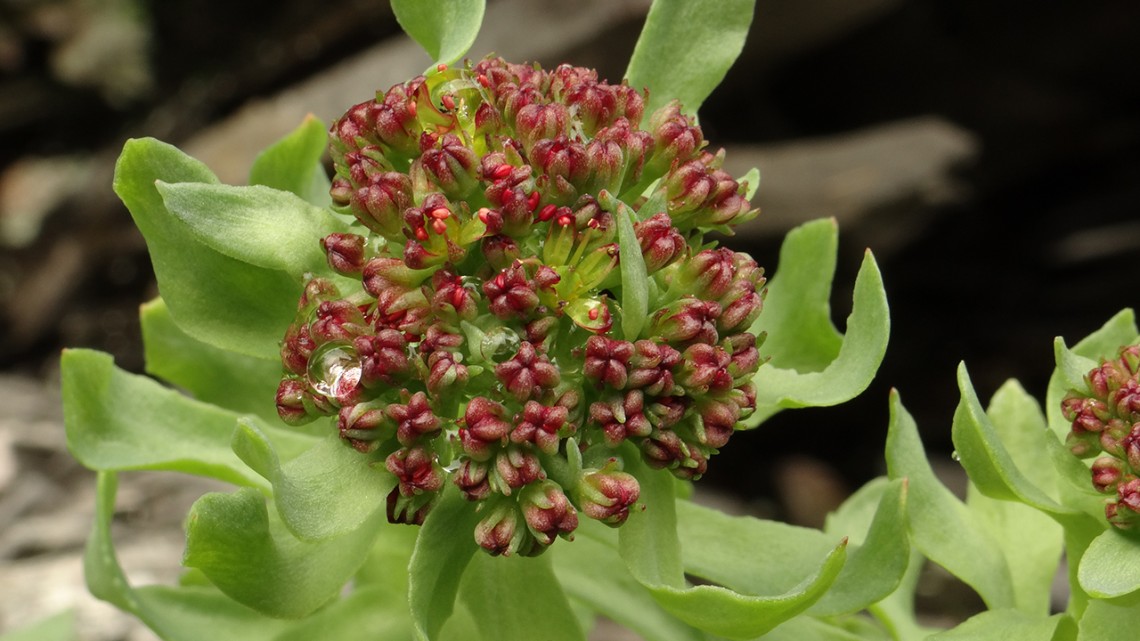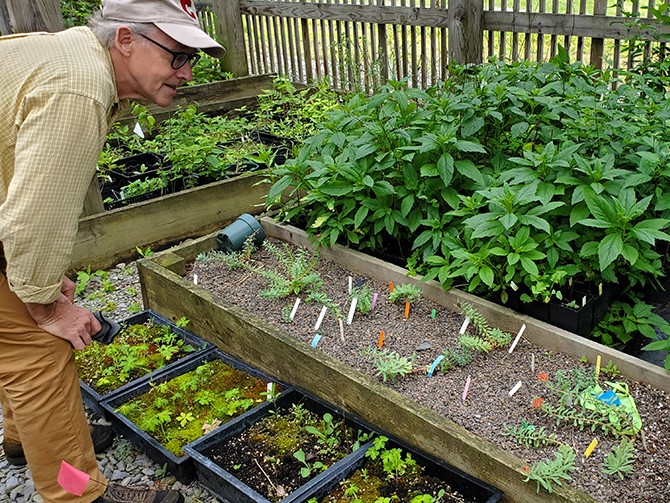
Leedy's roseroot, one of the rarest plants in the U.S., now established in Cascadilla Gorge by botanists and naturalists at Cornell Botanic Gardens.
Cascadilla Gorge offers a safe haven for rare species
By Anna Hooper
Thanks to a new conservation effort by Cornell Botanic Gardens, one of the rarest plants in the U.S. is now protected in the walls of Cascadilla Gorge.
Cornell Botanic Gardens staff has successfully established a population of the federally threatened Leedy’s roseroot and plans to foster a long-lasting population in the Cascadilla Gorge natural area.
Leedy’s roseroot, or Rhodiola integrifolia ssp. leedyi, exists only in five original sites across the U.S., including one along the west side of Seneca Lake in New York’s Finger Lakes Region. It boasts a lush red-orange flower and elongated stem, with waxy leaves extending throughout the length of the plant. It derives its name from the rose-like smell of its roots.
“With only one extant, original population in New York, there is always a risk of something happening and the plant becoming locally extinct,” said Todd Bittner, director of natural areas. “Establishing a second reproducing viable population is a key conservation strategy to help safeguard the species.”
To help conserve Leedy’s roseroot, Cornell Botanic Gardens staff and a cohort of interns traveled to Seneca Lake to carefully collect Leedy’s roseroot seeds by hand. The team propagated the seeds in the Botanic Gardens’ Plant Production Facility and in 2022 transplanted them in Cascadilla Gorge. The plants were established on a cool, north-facing drip wall in the gorge that mimics its cool-habitat preferences. The location is similar to the Seneca Lake habitat and is protected from slope erosion.
Of the 12 plants relocated, 11 survived, providing hope for the future of the plant. Leedy’s roseroot is particularly valuable to scientists studying ecosystems of earlier eras. Described as a ‘living fossil,’ Leedy’s roseroot dates to the Pleistocene era, more than 2 million years ago. By studying the plant, scientists can unlock past natural histories, such as identifying other organisms that lived at the time.
One reason for its federally threatened status is the perennial’s picky taste in habitat. The plant originated during a period when glaciers inhabited most of the continent, meaning it is adapted for cooler climates. Leedy’s roseroot prefers cool cliffs that mimic glacial conditions and supply the plant with the consistent moisture and cool temperatures it needs to thrive.
While the plant’s unique habitat is in part what makes it so special, its preference for cool-conditions poses significant risks for its future. With global temperatures continuing to rise, the plant’s habitat is under threat, says Robert Wesley, a botanist specializing in rare species at Cornell Botanic Gardens.
“Climate change surely threatens a plant that requires a cool microclimate and is a more northerly plant,” Wesley said.
The team plans to propagate another round of Leedy’s roseroot in summer 2024. The ultimate goal is to foster what Bittner calls a viable population.
“We intend to sustainably collect seeds annually from Seneca Lake and propagate individuals at our Plant Production Facility in order to establish at least one viable, self-sustaining population in our campus gorges,” Bittner said.
In addition, staff have collected and banked seeds in cold storage to preserve the germplasm for extended use.
“This is an insurance policy against losing an entire population and its valuable genetic diversity, Bittner says. “It also preserves the opportunity to use these seeds in the future for other reintroduction efforts.”
Throughout this process, botanic gardens’ staff have gathered valuable information about the plant’s preferred habitat and growth habits. The team discovered that an expanded shale substrate works well for propagating and growing the plant. They also learned that the timing of the transplanting must be conducted with precision. If the plant is too small, it will not survive. However, if the plant is too big, it will have a harder time establishing since gorge conditions provide shallow soil unsuitable for planting larger roots.
“Doing a reintroduction is always a bit of a trial and error,” Bittner said “We hope to learn more about the species through the project that can help conservationists working on the species elsewhere.”
Anna Hooper ’25 is a communications intern at Cornell Botanic Gardens.
Media Contact
Get Cornell news delivered right to your inbox.
Subscribe

